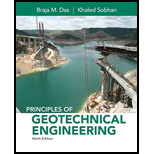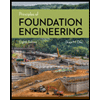
Principles of Geotechnical Engineering (MindTap Course List)
9th Edition
ISBN: 9781305970939
Author: Braja M. Das, Khaled Sobhan
Publisher: Cengage Learning
expand_more
expand_more
format_list_bulleted
Concept explainers
Question
Chapter 6, Problem 6.7P
(a)
To determine
The maximum dry unit weight and the optimum moisture content.
(b)
To determine
The moist unit weight at the optimum moisture content.
(c)
To determine
The degree of saturation (S) at the optimum moisture content.
(d)
To determine
The relative compaction for the required field dry unit weight of
(e)
To determine
The range of compaction moisture contents in the field to achieve the relative compaction.
(f)
To determine
The relative density of compaction in the field.
Expert Solution & Answer
Trending nowThis is a popular solution!

Students have asked these similar questions
Results of a standard proctor ompaction test on a silty sand are shown.
PLEASE COMPLETE SOLUTION.
1) Find the maximum dry unit weight and optimum moisture content.
2) What is the moist unit weight at optimum moisture content?
3) What is the degree of saturation at optimum moisture content? Given: ?? = 2.69
4) If the required field dry unit weight is 18.5 ??/?3, what is the relative compaction?
5) What should be the range of compaction moisture contents in the field to achieve the above relative compaction?
6) If the minimum and maximum void ratios are 0.31 and 0.82, respectively, what is the relative density of compaction in the field?
1. The relative compaction of a clayey sand in the field is 90%. In the laboratory, the maximum dry unit weight is 115 ??/??3. If the soil layer before compaction had a void ratio of 0.97 and a thickness of 5.5 ft. What would be the final thickness after compaction? Assume ?? = 2.67.
COMPLETE SOLUTION PLEASE
2. Situation 2 - For a constant laboratory permeability test on a fine sand, the following data are given:
Length of specimen = 16 cm
Diameter of specimen = 96 mm
Constant Head Difference = 50 cm
Volume of water collected in 4 min = 420 cc
Void ratio of the soil specimen = 0.55
a. Determine the hydraulic conductivity of the soil in m/min. Round off to four decimal places.
b. Determine the discharge velocity in m/min. Round off to four decimal places.
c. Determine the seepage velocity in m/min. Round off to four decimal places.
Chapter 6 Solutions
Principles of Geotechnical Engineering (MindTap Course List)
Knowledge Booster
Learn more about
Need a deep-dive on the concept behind this application? Look no further. Learn more about this topic, civil-engineering and related others by exploring similar questions and additional content below.Similar questions
- The relative compaction of a sand in the field is 94%. Given the dry unit weight maximum= 16.2 kN/m3 and the dry unit weight minimum = 14.9 kN/m3.For the field conditions Compute the relative density of compactionarrow_forwardFor a moist soil specimen, the following are given Gs= 2.67, volume = 0.5 m³ moist unit weight = 9.5 KN and the moisture content = 7.3%. Determine Dry unit weight, Void ratio, porosity, Degree of saturation.arrow_forwardSituation 2 - For a constant laboratory permeability test on a fine sand, the following data are given: Length of specimen = 16 cm Diameter of specimen = 96 mm Constant Head Difference = 50 cm Volume of water collected in 4 min = 420 cc Void ratio of the soil specimen = 0.55 a. Determine the seepage velocity in m/min. Round off to four decimal places. b. determine the discharge velocity in m/min. Round off to four decimal places.arrow_forward
- A fully saturated clay sample has a mass of 1526 grams. After oven-drying, its mass was reduced to 1053 grams. The specific gravity of the soil particles is 2.7. Determine water content percentage, void ratio, porosity, wet density (g/cm ), wet unit weight (kN/m ).arrow_forward9. The results of a Standard Proctoretest is tabulated as follows: (CHECK PICTURE) Determine the maximum dry unit weight of compaction Determine the void ratio at the optimum moisture content Gs = 2.68 Determine the optimum moisture content Determine the degree of saturation at the optimum moisture contentarrow_forwardA wet sand sample has a volume of 4.64 x 10-4 m3 and weighs 8N. After oven-drying, the weight reduces to 7.5N. Don't assume the value of Gs.Calculate the following: a. Void ratio b. Degree of saturation.arrow_forward
- For a constant laboratory permeability test on a fine sand, the following data are given: Length of specimen: 18 cm. Diameter of specimen: 95 mm. Constant head difference: 54 cm. Volume of water collected in 4.10 min.: 423 cc Void ratio of the soil specimen: 0.54 Determine the seepage velocity in m/min.arrow_forwardThe results of a constant-head permeability test for a fine sand sample having a diameter of 150 mm and a length of 300 mm are as follows • Constant-head difference = 500 mm • Water collected in 5 min = 350 cm3 • Void ratio of sand = 0.61 Determine: a. Hydraulic conductivity, k (cm/sec) b. Seepage velocityarrow_forward7. The relative compaction of a sand in the field is 94%. Given that dry unit weight max = 16.2 kN/m3 and dry unit weight min = 14.9 kN/m3 . For the field conditions. What is the relative density compaction? (Ans: 27%) What is the dry unit weight? (Ans: 15.23 kN/m3) What is the moist unit weight at a moisture content of 10%? (Ans: 16.45 kN/m3 )arrow_forward
- the maximum and minimum dry unit weights of a sand were determined in the laboratory to be 17.5kn/m^3 and 14.8kn/m^3. what should be the relative compaction in the field if the relative density is 70%?arrow_forwarda wet sand sample has a volume of 4.6 x 10^-4 m^3 and weighs 8.1 N. After oven-drying, the weight reduces to 7.5 N. Use Gs=2.59. Calculate the degree of saturation in decimal formarrow_forwardDetermine the maximum dry unit weight of compaction Determine the optimum moisture content Determine the void ratio at the optimum moisture content. Gs = 2.70 Determine the degree of saturation at the optimum moisture content A field unit determination test for the soil, yielded the following data. Moisture content = 12% and moist unit weight = 106 lb/cu.ft. Determine the relative compaction.arrow_forward
arrow_back_ios
SEE MORE QUESTIONS
arrow_forward_ios
Recommended textbooks for you
 Principles of Geotechnical Engineering (MindTap C...Civil EngineeringISBN:9781305970939Author:Braja M. Das, Khaled SobhanPublisher:Cengage Learning
Principles of Geotechnical Engineering (MindTap C...Civil EngineeringISBN:9781305970939Author:Braja M. Das, Khaled SobhanPublisher:Cengage Learning Fundamentals of Geotechnical Engineering (MindTap...Civil EngineeringISBN:9781305635180Author:Braja M. Das, Nagaratnam SivakuganPublisher:Cengage Learning
Fundamentals of Geotechnical Engineering (MindTap...Civil EngineeringISBN:9781305635180Author:Braja M. Das, Nagaratnam SivakuganPublisher:Cengage Learning Principles of Foundation Engineering (MindTap Cou...Civil EngineeringISBN:9781305081550Author:Braja M. DasPublisher:Cengage Learning
Principles of Foundation Engineering (MindTap Cou...Civil EngineeringISBN:9781305081550Author:Braja M. DasPublisher:Cengage Learning Principles of Foundation Engineering (MindTap Cou...Civil EngineeringISBN:9781337705028Author:Braja M. Das, Nagaratnam SivakuganPublisher:Cengage Learning
Principles of Foundation Engineering (MindTap Cou...Civil EngineeringISBN:9781337705028Author:Braja M. Das, Nagaratnam SivakuganPublisher:Cengage Learning

Principles of Geotechnical Engineering (MindTap C...
Civil Engineering
ISBN:9781305970939
Author:Braja M. Das, Khaled Sobhan
Publisher:Cengage Learning

Fundamentals of Geotechnical Engineering (MindTap...
Civil Engineering
ISBN:9781305635180
Author:Braja M. Das, Nagaratnam Sivakugan
Publisher:Cengage Learning

Principles of Foundation Engineering (MindTap Cou...
Civil Engineering
ISBN:9781305081550
Author:Braja M. Das
Publisher:Cengage Learning

Principles of Foundation Engineering (MindTap Cou...
Civil Engineering
ISBN:9781337705028
Author:Braja M. Das, Nagaratnam Sivakugan
Publisher:Cengage Learning